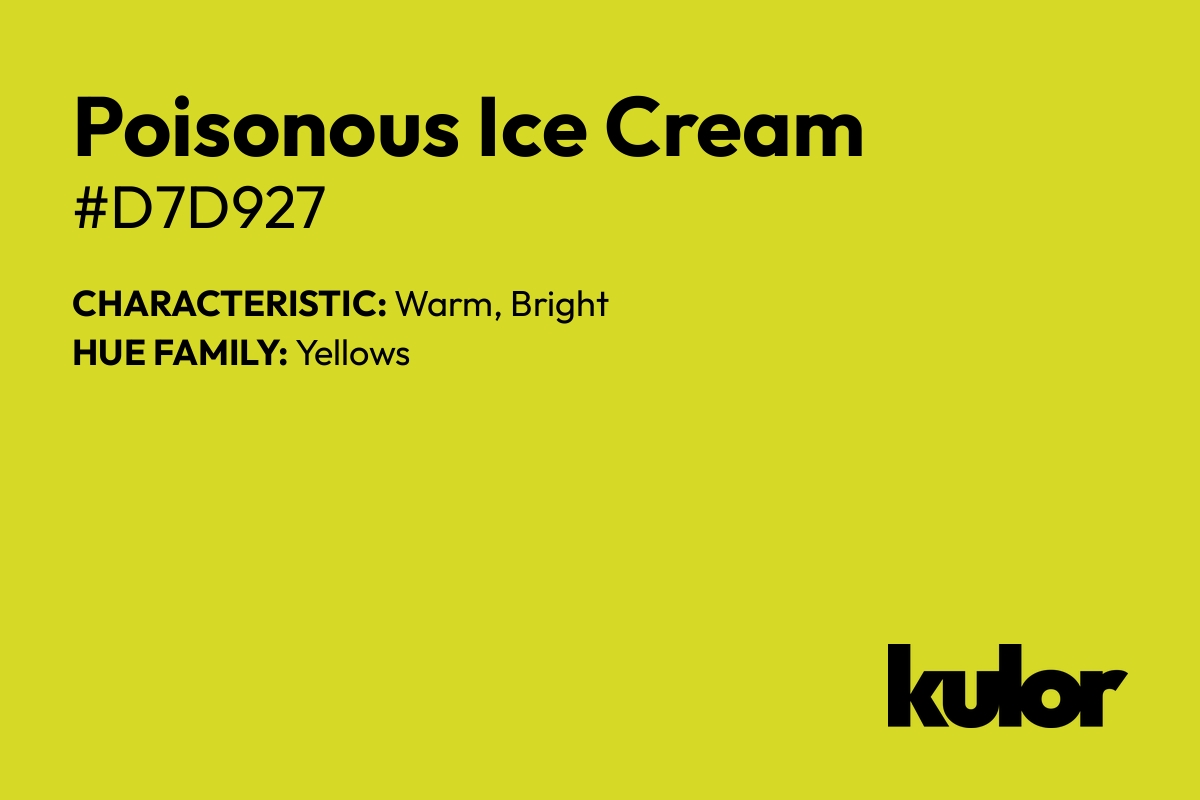Color Poisonous Ice Cream yellow (#d7d927):
HEX, RGB color codes for HTML and CSS
The Comprehensive Guide to Poisonous Ice Cream yellow (#d7d927):
Its Meaning and Harmonious Color Matches in Design.

Hue Family:
yellows
yellows Family:
neutral
Saturation:
highly saturated
Tones:
colorful tone
Shade:
light
Temperature:
neutral
Chromaticity:
chromatic
Chroma:
high chroma
Color Information about Poisonous Ice Cream / #d7d927
The HTML HEX code is #d7d927. The corresponding color name is "Poisonous Ice Cream". In RGB values (additive color space used for Digital Displays), this HEX code translates to Red (R): 215%, Green (G): 217%, Blue (B): 39%. In the CMYK color model (subtractive color model used in printing), it is represented by Cyan (C): 1%, Magenta (M): 0%, Yellow (Y):82%, Black (K): 15%. In the HSL color space, #d7d927 has a hue of 61°, saturation of 70%, and lightness of 50%. The HSV representation is 61° for hue, 82% for saturation, and 85% for value.
In the CIE-LAB color space, the color is denoted by L* (lightness) = 84, a* (green to red) = -19, and b* (blue to yellow) = 78. The XYZ representation is X: 53, Y: 64, Z: 12. In the YUV color space, it translates to Y (luminance) = 0.7691, U (chrominance) = -0.3032, and V (chrominance) = 0.0650.
The decimal value of the color is 14145831. The closest Web-safe HEX code is #CCCC33. Variations of the colour are #E6E87D for a 20% lighter version and #808217 for a 20% darker version.
For the color with hex value #d7d927, the correlated color temperature (CT) is estimated to be 3986 Kelvin (3986K).
The approximate wavelength of #d7d927 is around 579.17nm.
| VALUE | CSS | |
|---|---|---|
| HEX Code | d7d927 | #d7d927 |
| RGB Decimal Code | 215, 217, 39 | rgb(215, 217, 39) |
| CMYK | 1, 0, 82, 15 | / |
| HSL | 61°, 70%, 50% | hsl(61°, 70%, 50%) |
| HSV | 61°, 82%, 85% | / |
| CIE-LAB | 84, -19, 78 | / |
| XYZ | 53, 64, 12 | / |
| YUV | 0.7691, -0.3032, 0.0650 | / |
| Decimal value | 14145831 | / |
| Web-Safe HEX | CCCC33 | #CCCC33 |
| Color Temperature (CT) | 3986 Kelvin (3986K) | / |
| Estimate Wavelength | around 579.17nm | / |
The Depth and Diversity of Poisonous Ice Cream (Hex: #d7d927): Exploring its Impact in Design and Culture
Poisonous Ice Cream (#d7d927) resembles the vibrant yellow of a lemon soaked in sunlight. This hue exudes a sense of caution, mirroring the dangerous allure of a carnivorous plants bright petals. It shares similarities with the toxic glow of a radioactive symbol, catching the eye with a warning of potential harm. The color echoes the vibrant stripes of a venomous snake, enticing yet treacherous. Poisonous Ice Cream embodies the contrasting beauty and danger found in nature, making it a captivating shade that demands attention.
Download Stunning Poisonous Ice Cream Wallpapers and Backgrounds
Enhance your devices with our minimalistic yet captivating Poisonous Ice Cream Wallpapers, perfectly designed for 4K, 5K, iPhone, and Android screens. Experience a unique aesthetic that brings elegance to your digital life.
Experience Elegance with Poisonous Ice Cream 4K Wallpaper
Immerse yourself in the beauty of our Poisonous Ice Cream 4K Wallpaper, offering a resolution of 3840px by 2160px. Perfect for high-resolution displays, this wallpaper brings a touch of sophistication to your desktop.
Download Poisonous Ice Cream 4K WallpaperTints and Shades of #d7d927 HEX color (Poisonous Ice Cream)
In color theory, tints and shades are essential for understanding the depth and luminosity of colors. A tint is achieved by adding white to a pure hue, lightening its appearance. Conversely, a shade results from blending black with a color, giving it a deeper tone. In the context of #d7d927, this color stands at the center between its tints and shades. While the tints get progressively lighter moving towards white (#ffffff), the shades deepen towards black (#000000).
- #ffffff
- #F5F6C9
- #EBEC93
- #E1E35D
- #d7d927
- #A1A31D
- #6C6D14
- #36360A
- #000000
Tones of Poisonous Ice Cream (#d7d927 HEX color)
A tone is produced by adding gray to any pure hue. In the case of #d7d927, #b4b54b is the less saturated color, while #d7d927 is the most saturated one.
- #b4b54b
- #bdbe42
- #c6c739
- #ced030
- #d7d927
- #4e4e38
- #45452c
- #3d3d20
- #343414
HTML Usage Examples
HTML using color code example
<p style="color: #d7d927;">This is a css example</p>HTML / CSS Color Name using W3C
W3C HTML / CSS Color Name doesn't exist for #d7d927.
CSS color code example
p { color: #d7d927; }Text with hexadecimal color #d7d927
This is a sample text with color #d7d927.
Background Color with #d7d927
This is a example with background color #d7d927.
Border Color with #d7d927
#d7d927 Color Preview on White (#ffffff) Background
This is a example of text with color #d7d927 on white background.
#d7d927 Color Preview on Black (#000000) Background
This is a example of text with color #d7d927 on black background.
CSS codes examples
.text {color:#d7d927;}.background {background-color:#d7d927;}.border {border:1px solid #d7d927;}